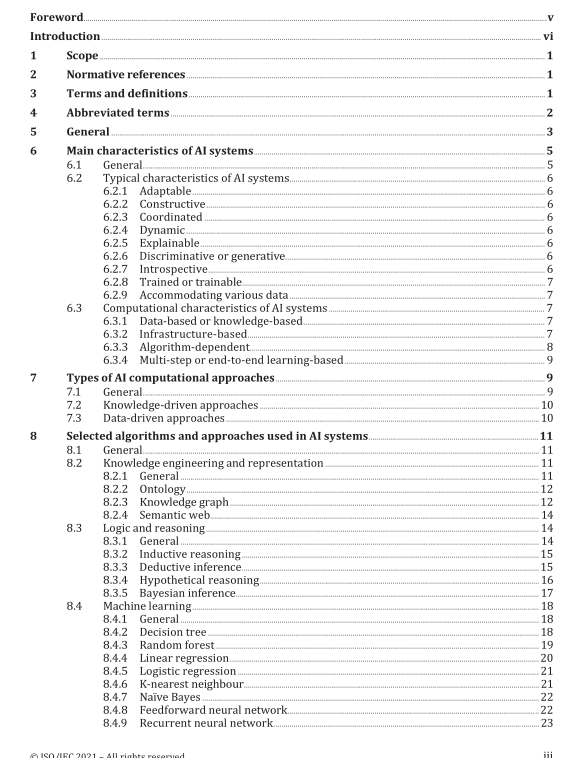ISO IEC TR 24372 pdf – Information technology — Artificial intelligence (AI) — Overview of computational approaches for AI systems

ISO IEC TR 24372 pdf – Information technology — Artificial intelligence (AI) — Overview of computational approaches for AI systems
2) Advanced search algorithms include those that search in a local subspace, those that are nondeterministic, those that search with partial observation of the search space and online versions of search algorithms.
3) Adversarial search algorithms search in the presence of an opponent and are generally used in games. These include notable algorithms such as alpha-beta pruning and also include stochastic and partially observable variations. 4) Constraint satisfaction problems are solved when each variable in the problem has a value that satisfies all the constraints.
b) Logics, planning and knowledge. These approaches can be further divided into three cases: logics, planning and state space search, and knowledge representation.
1) Logics, such as propositional logic and first-order logic, are used in classical AI to represent knowledge. Problem solution in such computational systems involves inference over the logic using algorithms such as resolution.
2) Planning in classical AI systems involves search over some state space as well as algorithmic extensions to deal with planning in the real world. Methods to deal with the complexity of real- world planning involve time and resource constraints, hierarchical planning where problems are solved at abstract levels first before fine-grain details, multi-agent systems that handle uncertainties and dealing with other agents in the system.
3) Knowledge representation is a kind of data structure for describing knowledge using predicate logic, “if-then” generation and knowledge frame representation.
c) Uncertain knowledge and reasoning. Approaches in this area deal with potentially missing, uncertain or incomplete knowledge. They generally use either probability or fuzzy logic to represent concepts. Probabilistic computational systems reason using Bayes rule, Bayesian networks or (in time-dependent situations) hidden Markov models or Kalman filters. Another set of computational approaches is used for decision-making, including those based on utility theory and decision networks.
d) Learning. Computational approaches in this area deal with the problem of making the computer learn similarly to a human. Approaches can be grouped into learning from examples, knowledge- based learning, probabilistic learning, reinforcement learning, deep learning approaches, GANs and other learning approaches.
1) Learning from examples involves supervised learning approaches that learn a machine learning model from labelled data. It includes methods such as decision trees, linear and logistic regression approaches, artificial neural networks, non-parametric approaches (e.g. the KNN), SVMs and ensemble learning methods (e.g. bagging, boosting and variants of random forest).
2) Knowledge-based learning approaches include logic-based approaches, explanation-based learning and inductive logic programming.
3) Probabilistic learning involves computational approaches such as Bayesian methods and expectation-maximization methods.
4) Reinforcement learning involves computational systems that receive feedback, make decisions and take actions in environments to maximize the overall reward. Notable algorithms include temporal difference-learning and Q-learning.
5) Deep learning neural approaches involve modern computational approaches with many hidden layers, including deep feedforward networks, regularisation, modern optimization methods, CNNs and sequence learning methods such as LSTM networks.









